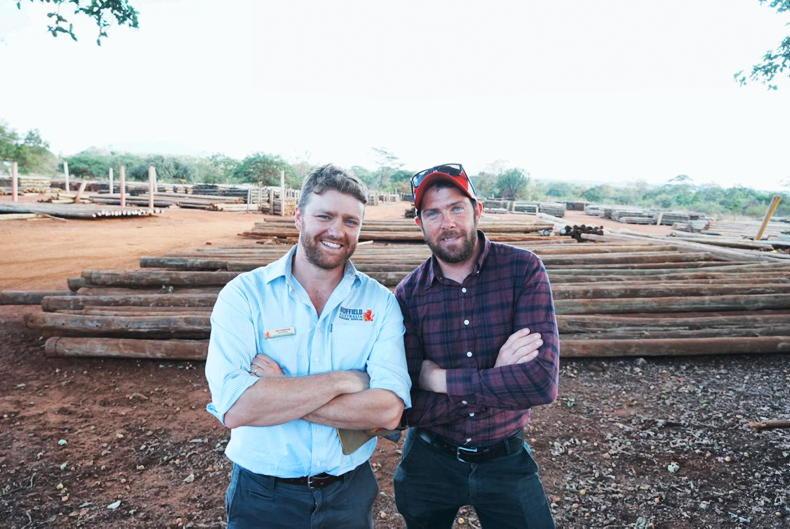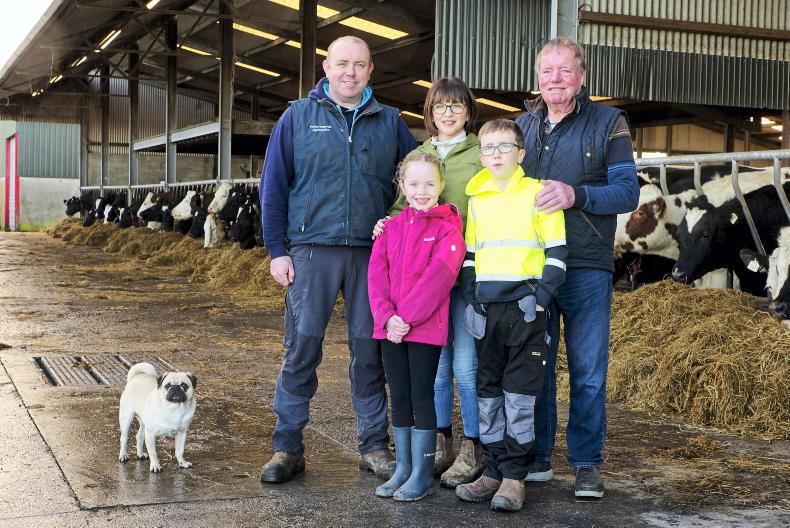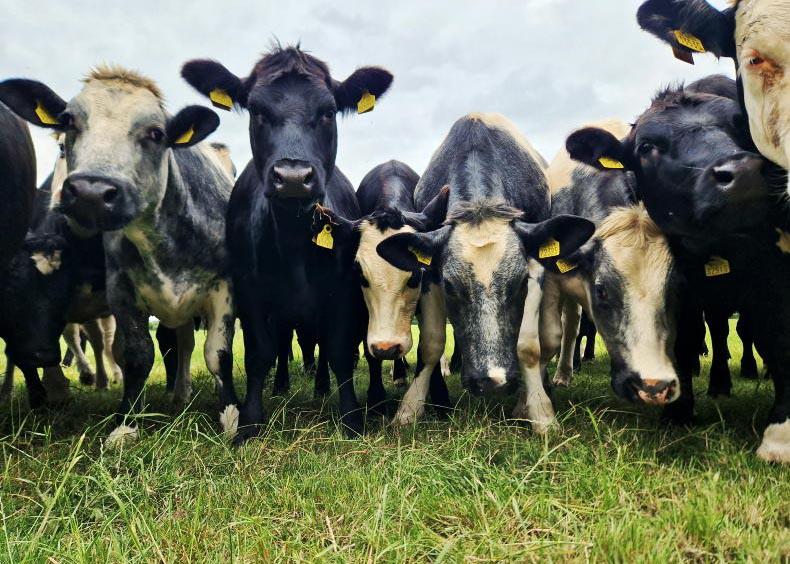Cathal is very honest when it comes to his farm set up, which is located just outside Castlebar town, off the main Ballinrobe-Castlebar road.
“I’m working off a small land base here. If you let it go, it would be all rushes, but I try and make the most of what I have here. There’s 18.76ha, with 4ha being silage ground and another 8ha being good grazing ground.
"After that it is peaty, heavy soil that can’t grow much. Even as I am with the better grassland, I can’t grow more than 10t/ha a year, it’s simply not in the ground. It’s too cold and wet.”
Cathal is one of the 22 farms taking part in the Teagasc Future Beef Programme, a group of farmers with a positive attitude towards suckler farming, who are willing to adapt to new technologies and develop efficiencies to improve profitability and reduce the negative effects of agriculture on the environment around them.
Farm system
Simmental-cross dominate the cow herd profile, with some Limousin blood also included. The herd is bred to a mix of stock bulls and AI, with 18% AI used (mainly on maiden heifers).
Bulls born on-farm are finished through to under 16-month bull beef, alongside some purchased bull weanlings, with heifers brought through the second winter to 13 months of age, where non-replacement heifers are sold live in the ring.
Key performance indicators
The farm is hitting or surpassing many of it’s key performance indicators. Last year, bull calves saw a birth-to-weaning average daily gain of 1.24kg/head/day, with heifers recording a daily liveweight gain of 1.09kg/head/day.
This was despite what Cathal described as an extremely challenging year from a management point of view, with a later turnout, weather and lack-lustre growth affecting the grazing season.
Calving interval is currently sitting at 385 days, with this being one of the main areas the farm looks to work towards getting back to 365 days.
The replacement index of the herd, which as mentioned is dominated by Simmental blood, sits at €144, €9 ahead of target. Carcase weight in the cows sits at 19kg (four stars), with daughter milk sitting at 9.6kg (five stars), showing the balance Cathal has brought to the herd between milk and carcase weight, essential for the under-16-month bull beef system.

Shane O’Haire, drystock adviser with TeagascMayo, alongside Cathal Irwin, Cloonfert, Castlebar, Co Mayo. \ Michael McLaughlin
Breeding aims
“I like the Simmental cow. She’s a good milker, she’s maternal, she has good calving ability and good fertility. I know you might compromise on shape, but I like them as a cow,’’ stated Cathal.
Stock bulls are used on mature cows, with Cathal working full time off-farm. Last year, Cathal made the decision to invest in a Simmental bull to run with the herd, something which he has back- tracked on this year a bit.
“Last year I got the brainwave that I had to get a Simmental bull, and that way I would have good heifers off them [the cows].
“I had my first crop of calves off that bull this year and I didn’t like them. The calves are nice, but there’s too much leg in them; there wasn’t enough hybrid vigour in them, so I am gone back to a Charolais bull again.”
The Charolais bull purchased is a son of Fiston, with Pirate and Nelson also in his back breeding. He carries a 5.8% calving difficulty on cows, with a terminal index of €128 (five stars) a carcase weight of 34.9kg (five stars ) and a carcase conformation of 2.06 (five stars).
Cathal feels that for the under 16-month bull beef system on-farm, that this bull will work best, with the high carcase and conformation scoring complemented by the frame and milking ability of the Simmental-cross suckler cows.
The Simmental stock bull remains on-farm, with the idea being floated that he will receive a small portion of the cows, possibly through using PRIDS.
The Dovea Genetics Limousin bull Ivantonov (LM5887) will be used on the maiden heifers at 15 months old, calving down at 24 months.
Grassland management
The 20 acres used as the main grazing block is split into 11 paddocks, which have all been reseeded over the last six years or so.
“I spread an opening round of fertiliser, get everything going. Once I get paddocks with a cover of 1,200kg DM/ha or so, I start off grazing, with 10 cows and calves currently at grass there now.
“I go out every week and measure grass. I’m measuring grass since 2017. I take the average farm growth for that week, say 55kg DM/ha.
“If I see a paddock drop down to a growth of 30kg DM/ha and it wasn’t just recently grazed, I’d go in with say 20 units N/ac and record it on PastureBase. I would aim to try to stretch applications out to get 25-30 days out of 20 units N.
“I have a very tight fertiliser allowance here. Last year I was out of fertiliser [allowance] very early in the grazing season. But that’s what I try and do.
“I have cows going in to realistically 6’’ to 8’’ of grass, a cover somewhere between 1,400-1,800kg DM/ha.”
Cows graze paddocks for two to three days before moving on, with the aim being to keep grass clean and fresh in front of stock.
Silage ground has already been grazed off, with 2,000 gallons/acre of slurry spread in the last two weeks. A mid-May cut is planned, with high DMD silage targeted for feeding to the weanling bulls and heifers.
A second cut and possible third cut will be made, with dry cow silage bought in from other farms. Despite the variable quality of this, it works well for the farm to buy-in this bulky silage as opposed to growing it, due to the high stocking rate for the land type.
18 suckler cow farm outside Castlebar, Co Mayo.Under 16-month bull beef and store heifer system, with bull weanlings bought in alongside homebred bulls.18.76ha, mix of peaty and decent grazing ground.8.9t/ha of grass grown in 2024.
Cathal is very honest when it comes to his farm set up, which is located just outside Castlebar town, off the main Ballinrobe-Castlebar road.
“I’m working off a small land base here. If you let it go, it would be all rushes, but I try and make the most of what I have here. There’s 18.76ha, with 4ha being silage ground and another 8ha being good grazing ground.
"After that it is peaty, heavy soil that can’t grow much. Even as I am with the better grassland, I can’t grow more than 10t/ha a year, it’s simply not in the ground. It’s too cold and wet.”
Cathal is one of the 22 farms taking part in the Teagasc Future Beef Programme, a group of farmers with a positive attitude towards suckler farming, who are willing to adapt to new technologies and develop efficiencies to improve profitability and reduce the negative effects of agriculture on the environment around them.
Farm system
Simmental-cross dominate the cow herd profile, with some Limousin blood also included. The herd is bred to a mix of stock bulls and AI, with 18% AI used (mainly on maiden heifers).
Bulls born on-farm are finished through to under 16-month bull beef, alongside some purchased bull weanlings, with heifers brought through the second winter to 13 months of age, where non-replacement heifers are sold live in the ring.
Key performance indicators
The farm is hitting or surpassing many of it’s key performance indicators. Last year, bull calves saw a birth-to-weaning average daily gain of 1.24kg/head/day, with heifers recording a daily liveweight gain of 1.09kg/head/day.
This was despite what Cathal described as an extremely challenging year from a management point of view, with a later turnout, weather and lack-lustre growth affecting the grazing season.
Calving interval is currently sitting at 385 days, with this being one of the main areas the farm looks to work towards getting back to 365 days.
The replacement index of the herd, which as mentioned is dominated by Simmental blood, sits at €144, €9 ahead of target. Carcase weight in the cows sits at 19kg (four stars), with daughter milk sitting at 9.6kg (five stars), showing the balance Cathal has brought to the herd between milk and carcase weight, essential for the under-16-month bull beef system.

Shane O’Haire, drystock adviser with TeagascMayo, alongside Cathal Irwin, Cloonfert, Castlebar, Co Mayo. \ Michael McLaughlin
Breeding aims
“I like the Simmental cow. She’s a good milker, she’s maternal, she has good calving ability and good fertility. I know you might compromise on shape, but I like them as a cow,’’ stated Cathal.
Stock bulls are used on mature cows, with Cathal working full time off-farm. Last year, Cathal made the decision to invest in a Simmental bull to run with the herd, something which he has back- tracked on this year a bit.
“Last year I got the brainwave that I had to get a Simmental bull, and that way I would have good heifers off them [the cows].
“I had my first crop of calves off that bull this year and I didn’t like them. The calves are nice, but there’s too much leg in them; there wasn’t enough hybrid vigour in them, so I am gone back to a Charolais bull again.”
The Charolais bull purchased is a son of Fiston, with Pirate and Nelson also in his back breeding. He carries a 5.8% calving difficulty on cows, with a terminal index of €128 (five stars) a carcase weight of 34.9kg (five stars ) and a carcase conformation of 2.06 (five stars).
Cathal feels that for the under 16-month bull beef system on-farm, that this bull will work best, with the high carcase and conformation scoring complemented by the frame and milking ability of the Simmental-cross suckler cows.
The Simmental stock bull remains on-farm, with the idea being floated that he will receive a small portion of the cows, possibly through using PRIDS.
The Dovea Genetics Limousin bull Ivantonov (LM5887) will be used on the maiden heifers at 15 months old, calving down at 24 months.
Grassland management
The 20 acres used as the main grazing block is split into 11 paddocks, which have all been reseeded over the last six years or so.
“I spread an opening round of fertiliser, get everything going. Once I get paddocks with a cover of 1,200kg DM/ha or so, I start off grazing, with 10 cows and calves currently at grass there now.
“I go out every week and measure grass. I’m measuring grass since 2017. I take the average farm growth for that week, say 55kg DM/ha.
“If I see a paddock drop down to a growth of 30kg DM/ha and it wasn’t just recently grazed, I’d go in with say 20 units N/ac and record it on PastureBase. I would aim to try to stretch applications out to get 25-30 days out of 20 units N.
“I have a very tight fertiliser allowance here. Last year I was out of fertiliser [allowance] very early in the grazing season. But that’s what I try and do.
“I have cows going in to realistically 6’’ to 8’’ of grass, a cover somewhere between 1,400-1,800kg DM/ha.”
Cows graze paddocks for two to three days before moving on, with the aim being to keep grass clean and fresh in front of stock.
Silage ground has already been grazed off, with 2,000 gallons/acre of slurry spread in the last two weeks. A mid-May cut is planned, with high DMD silage targeted for feeding to the weanling bulls and heifers.
A second cut and possible third cut will be made, with dry cow silage bought in from other farms. Despite the variable quality of this, it works well for the farm to buy-in this bulky silage as opposed to growing it, due to the high stocking rate for the land type.
18 suckler cow farm outside Castlebar, Co Mayo.Under 16-month bull beef and store heifer system, with bull weanlings bought in alongside homebred bulls.18.76ha, mix of peaty and decent grazing ground.8.9t/ha of grass grown in 2024.











SHARING OPTIONS